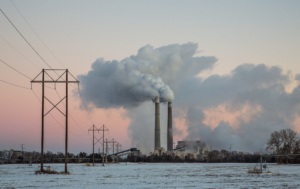
The Trump administration’s latest attack on the environment, via the Pruitt-led EPA, loosens emission restrictions on major industry sources such as power plants and factories and undermines policies first adopted under the Clean Air Act in 1995. Under the Act, a facility was “classified as ‘major’ if it had the potential to emit more than 10 tons of an individual toxic chemical or 25 tons of a combination of toxics into the air per year.” Those facilities exceeding this limit had to adopt “maximum achievable control technology” (MACT), meaning they had to install the most health-protective emissions reduction mechanisms.
The new EPA guidance removes the status of the facility as a “major source” once that source reduces its pollution below the threshold, lifting the facility’s obligation to continue using the MACT mechanisms — meaning their emissions could potentially become unregulated.
This is one step in many since the Reagan era to undermine federal environmental protections in favor of big business. Ronald Reagan cut funding to the EPA by 22 percent blaming environmental regulations for the flight of manufacturing oversees — the same lie that Trump is using as he paves the way for a return to coal production and offshore oil drilling.
But there are some loopholes in relation to the new EPA changes both in favor of progress and against. Because California already had emissions regulations in place when the 1963 Clean Air Act was adopted, the state was granted the right under the Act to adopt its own stricter regulations. Although on the Trump/Pruitt hit list, this California exemption so far has been upheld and would require a change to the Clean Air Act to undo — a long-term battle that would likely exceed Trump’s term in office.
The California exemption has allowed states to opt in to the stricter standards which provide stronger public health protections than the federal limits. “Beyond motor vehicle air emissions standards (through opting in to California’s standards), states have broad authority to be more protective than the federal government, including but not limited to setting strict standards for water quality, air emissions from oil refineries, power plants, and other stationary sources of air pollution, and hazardous substances contamination.”
“States rights” are generally used for reactionary goals, and in the case of environmental protections, it can go both ways. Thirteen states and the District of Colombia have adopted California’s stricter vehicle emissions standards, while other states, such as South Dakota, have passed laws blocking any environmental regulations that are more restrictive than the national standards, which is essentially a handout to the state’s abundant mining and fossil fuel industry.
But we must also consider that the worldwide trend — at least for those nations who have the resources to do so — is toward stricter regulations and away from fossil fuels to renewables. Of course, not nearly fast enough to avert climate catastrophe, but that’s another article.
Industry in general sees the writing on the wall, and while always looking for loopholes to increase profits, will continue utilizing the costly emissions controls they have already installed. Much of industry suspects that the Trump/Pruitt trend may not roll over into future administrations and plan to keep their existing mitigation technologies in place rather than undo them only to find a return to stricter regulations in two and a half years. Industry is slow to move on implementing changes, for better or worse, which in this case could be to the public’s benefit.
While not saying the U.S. has ever done its fair share to combat climate change, outside of Trump, other administrations have made some concessions if only to save face within the international arena. So industry will likely wait out the Trump term to see if the federal government continues on the climate-change-denial course before making changes that may incur greater costs down the road.
We need to see this latest attack in the context of the bigger picture of the dismantling of environmental protections over the last year. National Geographic has a running tally of all the abhorrent anti-environmental policies that Trump has enacted so far.
The list includes:
- Overturned Obama-era bans on offshore oil and gas drilling in parts of the Arctic, Pacific, and Atlantic Ocean
- Deletion of all references to climate change from government websites
- Removal of climate change from list of national security threats
- Removal of the national monument designation from large parts of Grand Escalante Staircase and Bears Ears
- Auction off 77 million acres of federal waters in the Gulf of Mexico for oil and gas leases
- Withdrawl from U.S. Clean Power Plan, which would have cut carbon emissions in the energy sector by 32 percent from 2005 by 2030
- Revoked federal flood-risk standards that accounted for sea-level rise
- Attacked protections on wildlife from bird species to whales
- Pulled out of the Paris Climate Agreement
- Overall, cut 31 percent of the EPA budget
- Refused to ban pesticide chlorpyrifos that causes brain damage in children and farm workers
- Gave the green light for Dakota Access and Keystone XL pipelines
And the list goes on …
While the latest attacks are another step backwards in policy, public pressure from below and protest in the streets and in the halls of power at the local and state level can push local governments to go beyond the weak federal regulations. In the end what is needed is a government that truly represents the people, that does not sacrifice public health for corporate profits. Socialism is that system.





